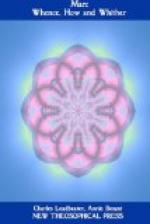You may answer that this is to be explained by the law of correlation of organs; that when changes in one organ demand corresponding changes in another, these two change similarly and more or less at the same time and rate. But this is evidently not an explanation but a restatement of the fact. The question remains, What makes the organs vary simultaneously so as to always correspond to each other? The whole series of changes must to some extent be effected at once and in the same individual, if it is to be preserved by natural selection. Fortuitous variations here and there along the line of the series are of little or no avail. That the whole series of variations should happen to occur in one animal is altogether against the law of probabilities; if the favorable variation occurs in only a part of the series it remains useless until the corresponding variation has taken place in the other terms. And while the variation is thus awaiting its completion, so to speak, it is useless, and cannot be fostered by natural selection.
Evolution by means of fortuitous variations, combined and controlled only through natural selection, seems to me at least impossible; and this view is, I think, steadily gaining ground.
Natural selection, while a real and very important factor in evolution, cannot be its sole and exclusive explanation. It presupposes other factors, which we as yet but dimly perceive. And this does not impeach the validity of Mr. Darwin’s theory any more than Newton’s theory of gravitation is impeached by the fact that it offers no explanation as to why the apple falls or how bodies attract one another.
For natural selection explains the survival, but not the origin, of the fittest. Given a species or other group composed of more and less fit individuals and the fittest will survive. How does it come about that there are any more and less fit individuals? This brings us to the consideration of the subject of variation.
Let us begin with a simple case of change in the adult body. The workman grasps his tools day after day, and his hands become horny. The skin has evidently thickened, somewhat as on the soles of the feet. This is no mere mechanical result of pressure alone. Continuous pressure would produce the opposite result. But under the stimulus of intermittent pressure the capillaries, or smallest blood vessels, furnish more nutriment to the cells composing the lowest layer of the outer skin or epidermis. These cells, being better nourished, reproduce by division more rapidly, and the epidermis, becoming composed of a greater number of layers of cells, thickens. The outer-most layers, being farthest from the blood supply, dry up and are packed together into a horny mass.
If I go out into the sunshine I become tanned. This again is not a direct and purely chemical or physical result of the sun’s rays, but these have stimulated the cells of the skin to undergo certain modifications. Any change in the living body under changed conditions is not passive, but an active reaction to a stimulus furnished by the surroundings. The same stimulus may excite very different reactions in different individuals or species.




